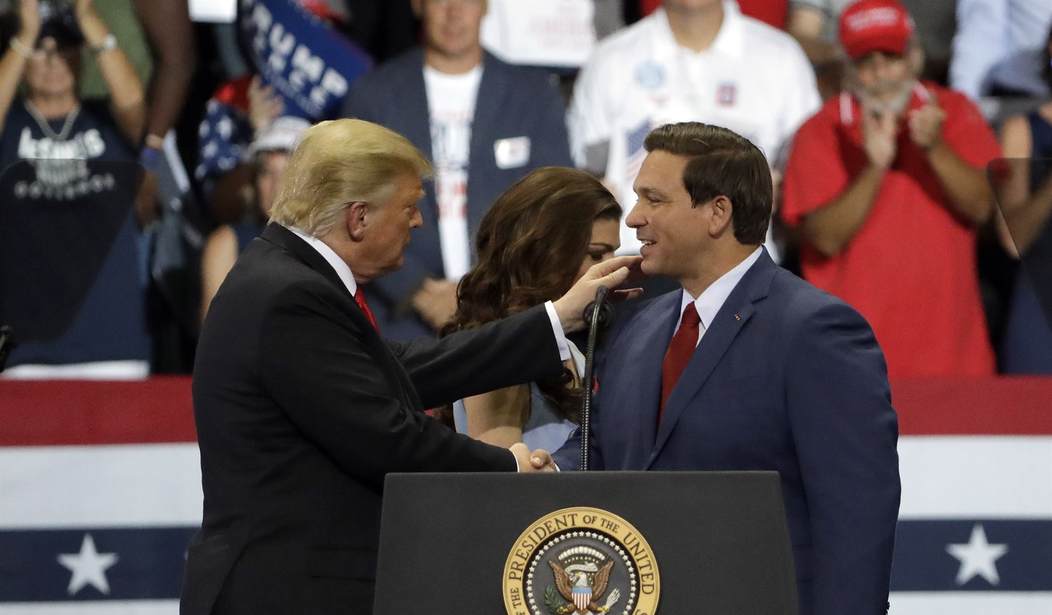Eeeeenteresting, even if polling for 2024 at this stage is mainly for entertainment value — and maybe this one in particular. The result of this iteration of the USA Today/Suffolk poll — with a smallish sample, to be sure — would catch the eye in any case. The more interesting aspect is in the comparison to a survey in the same series earlier in the year.
If Donald Trump was hearing footsteps before now in Florida …
Former President Donald Trump’s support among Republican voters in Florida for another presidential bid has significantly eroded this year, a USA TODAY/Suffolk University Poll finds, as Gov. Ron DeSantis has scored gains in the home state they now share.
In a hypothetical 2024 presidential primary in the Sunshine State, DeSantis now leads Trump 48%-40%. That’s a reversal from a USA TODAY/Suffolk Poll of Florida in January, when Trump led DeSantis 47%-40%.
“This doesn’t necessarily mean DeSantis would lead in any other GOP primary state,” said David Paleologos, director of the Suffolk University Political Research Center. “But it is one data point suggesting a shift in preferences from GOP voters away from Trump and toward DeSantis from Republicans who know both potential combatants quite well.”
Indeed, and this should come with a few caveats. In the first place, the sample size here is 500 likely midterm voters — not too small, but not exactly a robust sample. The sample of Republican voters, however, only consists of 174 respondents, which is an absurdly small sample for a predictive poll. The overall margin of error is ±4.4%, but the MoE on the GOP subsample is ±7.4%. That covers the gap between Trump and DeSantis in both polls.
Literally, the only firm conclusion one can take from this result is that both men would be the leaders for the nomination if the primary was held today. Which it won’t be — it will be held in eighteen months, give or take. The likely-voter model applied here, at least by USA Today’s reporting, isn’t even a likely-voter model for that primary but instead for the upcoming midterm, so the model is likely less predictive, adding that to the sample size issue.
And did we mention that DeSantis is on the midterm ballot while Trump is not?
Anyway, those are the main reasons to approach polls like these with a sense of entertainment rather than information. Are there reasons to take this seriously? Perhaps, at least obliquely. For one thing, even with a small sample, some of the demos might have value, although the MoEs there would also be astronomical:
Trump leads 53%-36% among voters earning less than $50,000 a year; DeSantis leads 55%-33% among those who earn $50,000 or more a year. Trump leads 57%-27% among voters who have not attended college; DeSantis leads 60%-30% among those who have.
Then there are the backers of Rubio, who was trounced by Trump in the Florida presidential primary in 2016, 46%-27%. The senator’s supporters now split for DeSantis, 51%-38%.
The other potential value is in the trendline. The gap in this case moved fifteen points in DeSantis’ direction. That’s also within the MoE (which should be doubled when looking at results such as these), but only barely. That looks like some actual momentum apart from the sample-size issues, and it’s remarkable to see that while Trump has successfully seized the media spotlight and grievance mantle over the Mar-a-Lago raid. Normally that would redound to Trump’s benefit and result in a rally effect around the once-and-future president.
And maybe it has, to some extent. However, it also appears that DeSantis has at least kept pace with Trump on the PR front as a party leader, and maybe has begun to eclipse Trump a bit on that role. That could signal that while Trump has a lot of support in general –in Florida, mind you, where this poll took place — DeSantis is emerging as the kind of alternate pugnacious candidate for Republicans in 2024.
That’s about as much as this tells us for now … except that the popcorn passing over the next year or so will be tremendous.








Join the conversation as a VIP Member